Disclaimer: Weldingzilla.com supports our readers with industry knowledge & research. You support us through our carefully chosen products with links that may earn us a commission.
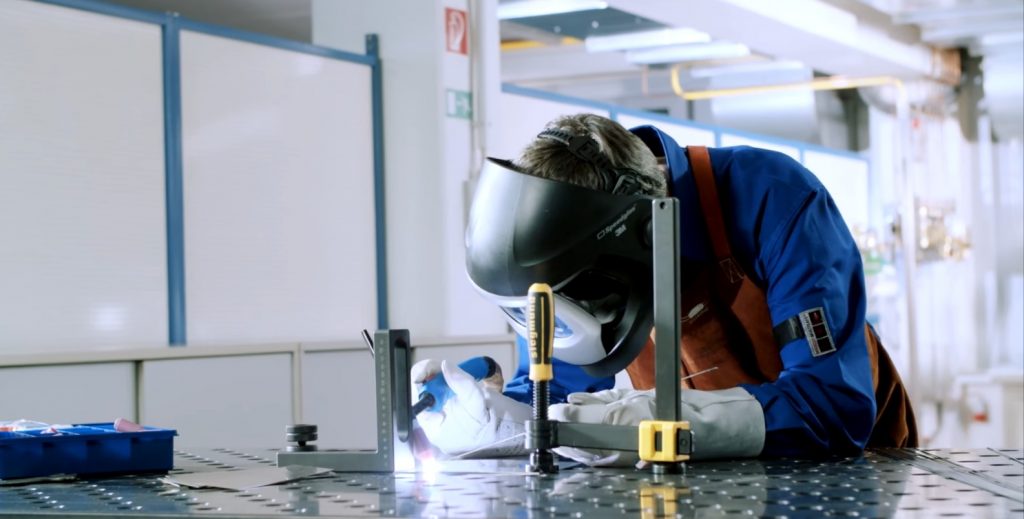
As someone who’s been in the welding industry for over two decades, I’ve had the opportunity to use a variety of helmets from multiple brands in different use cases, like Miller, Optrel, Lincoln, and ESAB.
And while it may be tempting to save a few bucks on cheap brands imported from China, the truth is that these helmets often don’t provide the protection and features you need to work safely and efficiently. They usually end up in the trash.
When select the best options, I look for:
- Viewing area
- Optical clarity
- Comfort & head strap adjustability
- Tech features
- Construction quality
- Brand reputation
My personal favorite is the Lincoln Viking 3350. It ticks all the boxes above, with excellent visibility, versatility with all processes including TIG and is the most used helmet among professionals I know.
Note: I purposefully avoided the cheapest helmets as I have had bad experiences with them. Either they weren’t reliable, the parts were hard to find, or their support was non-existent. If you’re on a tight budget, check out my cheap welding helmets guide under $100.
With that in mind, let’s dive in.
Comparison Table:
| Image | Product | Features | Price |
|---|---|---|---|
 | YESWELDER True Color Solar Powered Auto Darkening Welding Helmet |
| Check Price |
 | TR Industrial Forestry Safety Helmet |
| Check Price |
 | YESWELDER Large Viewing Screen 3.94″X3.66″ True Color Solar Power |
| Check Price |
 | DEKOPRO Welding Helmet Solar Powered Auto Darkening Hood |
| Check Price |
 | YESWELDER Anti Fog Up True Color Solar Powered Auto Darkening |
| Check Price |
 | Hobart 770890 Auto-Darkening Welding Helmet |
| Check Price |
 | GoGonova 3.94”×3.82” Large View Welding Hood, |
| Check Price |
Best Welding Helmets
Below you will find a list of the best welding helmets according to our expert opinion for 2024
1. Lincoln Electric 3350 Auto-Darkening Welding Helmet
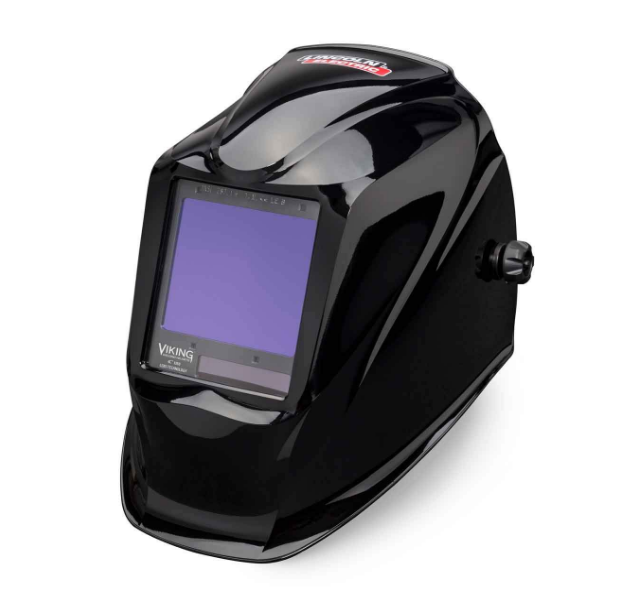
If you’re looking for the best all-round welding helmet, then look no further than the classic Lincoln Viking 3350. It’s an established model in the welding community and is used by professionals in all industries. This is the 4th generation, which is the best value, but Lincoln have just introduced the 5th generation that includes a advanced digital controls, work light and Bluetooth tech.
Lincoln Electric’s updated Viking 3350 offers the best optical clarity among high-end welding helmets. It rates as 1/1/1/1. This ranking means your image will not distort in any way.
However, the color and light transmission are almost identical to the ESAB Sentinel A50. So, Optrel and Miller have a transmission advantage over the Viking 3350, which is worth noting since the 3350 is more expensive than the Miller Digital Infinity. Still, many welders prefer Lincoln’s 4C technology, and they still enjoy excellent color accuracy.
Lincoln designed the Viking 3350 for heavy-duty work, not just precision welding. The shell is durable and features a simple, low-profile design. This hood can be showered with sparks and molten debris daily and survive for years.
Also, Lincoln Electric redesigned the headgear with a new “K3034-4” model of the 3350, making it more comfortable and easier to adjust. Just be sure you buy the new matte black version, not the old glossy version. The old helmet offered just as good color and light transmission, but the headgear was a pain for many welders.
Pros
- Excellent light and color transmission
- Best-in-class optical clarity
- Lightweight considering the size of the ADF
- Rated for low TIG starting amps
- Extra-large viewing area
- External grind mode button
- DIN 3.5 in grinding mode
- Quality headgear that’s easy to adjust
- Integrated “always-on” protection against sunlight triggering the ADF
- Rugged, durable shell body
- Uses standard CR2450 replaceable battery
- Popular with US welders
Cons
- Expensive
- No digital contro
2. 3 M SPEEDGLAS ANSI Certified Welding Helmets
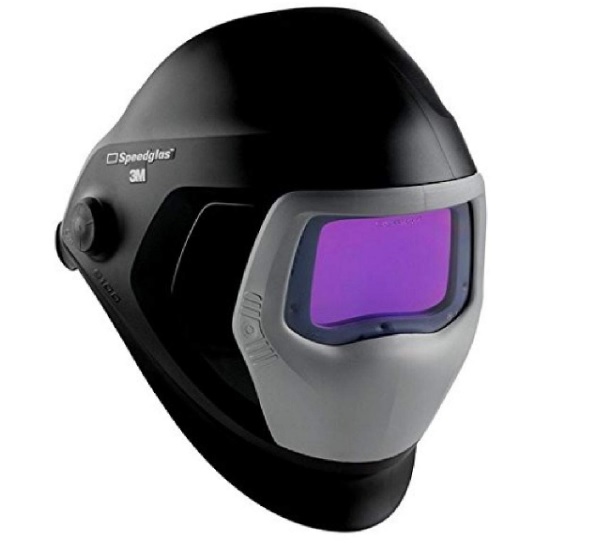
The Speedglas 9100 is the most durable auto-darkening welding helmet. 3M designed it for mining, marine, transportation, and heavy manufacturing. If you want a helmet that can handle demanding work in rough industries, the Speedglas 9100 is a good choice.
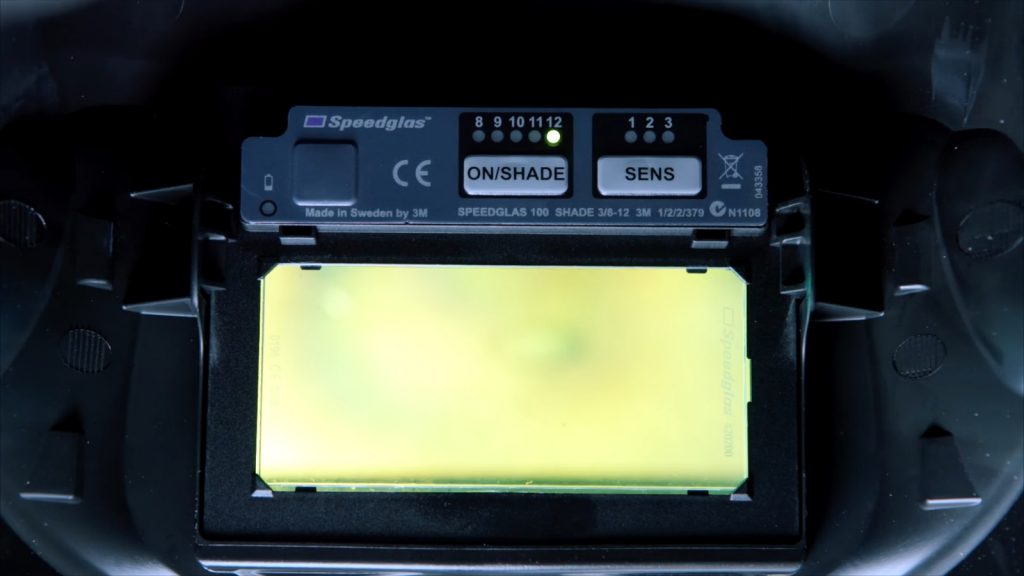
The included 9100XXi ADF offers excellent color and light transmission on par with the ESAB Sentinel and the Lincoln Electric 3350. But, it provides a DIN 3 shade, while ESAB comes with a DIN 4 rating and Lincoln a DIN 3.5. Still, the Speedglas 9100 costs about the same as the Optrel Panoramaxx CLT and has poorer view quality. So, the Speedglas 9100 makes sense when you need maximum durability. Optrel and ESAB couldn’t endure the same working conditions 3M designed the Speedglas 9100 to withstand.
The headgear is well designed and features padded headbands to distribute pressure evenly. However, some head shapes may require more fiddling to find the sweet spot.
The helmet includes an external grind button and huge side windows. 3M designed the entire build to improve productivity in adverse environments. But, the 3M Speedglas 9100 also excels as a precision welding helmet thanks to the best TIG rating on the market. So, while expensive, you get an all-rounder hood for pretty much every job.
Pros
- Excellent light and color transmission
- Large view area
- Heavy-duty design made for industrial applications
- Best low TIG amp rating on the market
- DIN 3 light shade
- External grind button
- Features large DIN 5 shade side windows for peripheral vision
- Replaceable battery
- Ergonomic, adjustable headgear
- Shell design allows sufficient airflow inside the helmet, which prevents fogging up the lens
- Effortless adjustments and set up
- Accessing the settings is a breeze
Cons
- Large price tag
- Filter has a slight green tint
- Headgear doesn’t allow sufficient adjustability for some head shapes
- Pressing the grind mode button requires too much force; you can push the helmet to the side if it’s not tightly fitted to your head
3. Esab SENTINEL A50 Auto Dark Welding Helmet
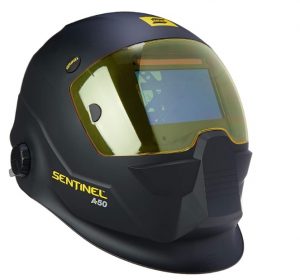
If you’re a seasoned professional or simply seeking a top-tier welding helmet at a more affordable price, the ESAB Sentinel A50 is your ideal choice. It stands as the most affordable professional-grade helmet tailored for heavy-duty applications and precision TIG welding thanks to the low amp range.
Only the Optrel Panoramaxx and Miller Digital Infinity are better with color and light transmission. So, the Sentinel A50 does qualify as a premium auto-darkening welding helmet. The view quality is best when TIG welding. The blueish tint and crystal clear image let you see the tiniest details. You can easily spot the most nuanced burn and bubble or sense when your weld pool has poor shielding gas coverage.
ESAB built every aspect of their HALO headgear to increase comfort and adjustability from the ground up. The Sentinel A50 matches the comfort level of high-end welding helmets from Miller and Optrel. But the Sentinel A50 is not well suited for people with large heads. Size can be subjective, but consider an Optrel helmet if you’ve had issues finding a hood large enough to fit your head before.
The spherical lens gives the Sentinel its characteristic “cool factor.” But the lens is also responsible for increased light transmission and helmet’s durability, and sparks easily slide off the spherical lens. However, these lenses are a double-edged sword. The internal glare is more pronounced, and replacement lenses are more expensive than standard rectangular lenses.
Pros
- Exceptional color and light transmission
- Digital controls with 8 memory settings
- External grind button with a shade 4 configuration
- Least expensive high-end welding helmet
- Uses replaceable batteries
- A spherical front cover lens improves natural light transmission
- The helmet design allows slag and spark to slide off easily without getting stuck in crevices
- Exceptional headgear comfort and adjustability
- Durable – made for heavy-duty work
- Top-of-the-line TIG welding experience
- Low profile design
Cons
- Spherical lens easily scratch if the helmet is placed face down
- The touchscreen display requires taking your gloves off
- Spherical lenses increase glare on the inside
- Replacement lenses are costly
4. Jackson Safety Bh3 Welding Helmet – Auto dim welding helmet
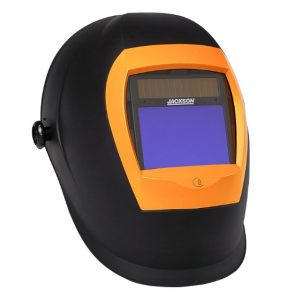
Our Review
With a comprehensive optical clarity rating, you are assured of seeing your work in detail with the Jackson safety BH3. A high-density synthetic shell retains you protected and safe.
Its weight of 2 Pound is pretty substantial for the price range and won’t be as comfortable for prolonged projects, The Shade range from 9 to 13, making it less movable than the previous choices on the list.
The headgear is easy to adjust, though not as satisfactory as similar helmets. The Jackson Safety BH3 welding helmet is one of the best-rated auto-darkening welding helmets.
6. Hobart Impact Welding Helmet – Best welding helmet for TIG

If you are a hobbyist but feel more comfortable with a brand-name helmet, the Hobart Inventor model may be a good choice. The YesWelder 900B we recommended earlier for hobbyists supports far more features. But, the Inventor by Hobart comes with a longer warranty. Still, you should know that the Inventor helmet is manufactured in China, just like the YesWelder 900B.
The Hobart Inventor uses a standard ADF lens that doesn’t support true color technology. But, thanks to the large view area and quality ADF, the visual experience is quite good. It’s much better than most inexpensive “standard” ADF helmets.
Hobart didn’t rate the Inventor for optical clarity. However, the light DIN 3 state means that it almost certainly rates at 1/1/1/2, which is on par with many professional helmets.
The headgear is comfortable but basic. An external grind mode button is missing, and there is no cutting mode. So, this helmet only supports weld and grind modes, and you are forced to use a dark DIN 9 to plasma cut, which is too dim for plasma arc. Other competing helmets support DIN 5-9 for cutting.
Pros
- Inexpensive given the build quality
- Relatively large viewing area
- Durable plastic shell
- Multi-point adjustable headgear
- Uses replaceable batteries
- Lightweight
- LED grind mode indicator on the inside
Cons
- Doesn’t support advanced methods of light and color transmission like true color technology
- Internal grind mode switch
- Basic headgear
- Doesn’t support plasma cutting mode; DIN 5-9 shades are not available
7. Miller Digital Elite Black Welding Helmet -Auto darkening welding helmet Review
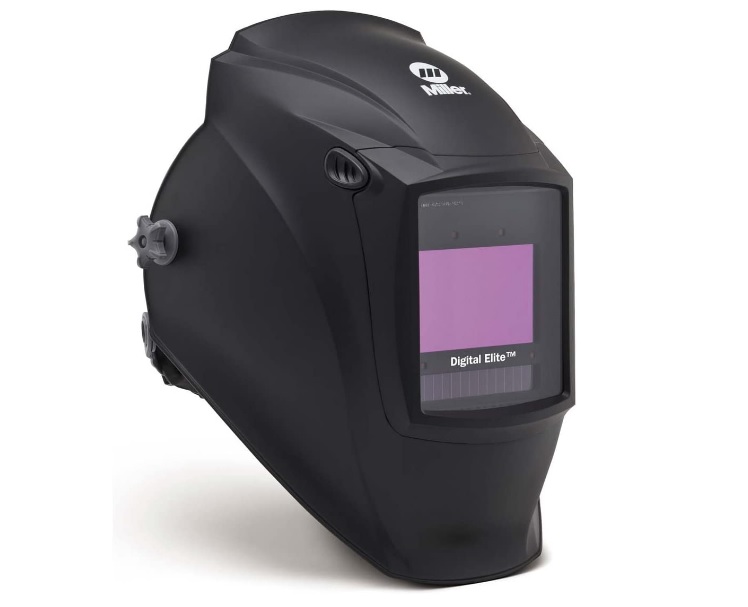
Miller’s Digital Infinity is an iconic auto-darkening helmet used by professional welders worldwide. It’s more expensive than the Sentinel A50 and has slightly better light and color transmission.
This welding helmet is rugged and can take a beating. You don’t have to pamper it, unlike the ESAB and Optrel models. But, 3M offers even more durable helmets.
The big lens provides the largest viewing area among welding helmets with rectangular lenses. Optrel’s Panoramaxx CLT still provides a far wider field of view, thanks to its nose-cut shape, but Miller’s replacement lenses are inexpensive and readily available.
The most prominent feature of the Digital Infinity is its X-mode. It triggers the ADF by detecting the arc’s electromagnetic field. Since it doesn’t rely on the arc’s IR/UV waves, it cannot initiate false darkening when flashed by the sun or lights in the work area. The X-mode makes this the most versatile auto-darkening helmet because you can weld outside and inside and never worry about false activation or getting flashed.
The Digital infinity comes in many designs, and my favorite is Black Ops. But if you don’t need a large viewing area, consider the Digital Elite. It has all the features of the Digital Infinity, but it’s costs less.
Pros
- Excellent color and light transmission; slightly better than the ESAB Sentinel A50
- Biggest viewing area of all welding helmets with standard lens shape
- Miller’s X-mode triggers ADF based on electromagnetic arc detection
- DIN 3 light state for grinding
- Ergonomic headgear
- Easy-to-use digital controls
- Rugged and durable
- AutoSense mode for automatic sensitivity adjustment
- InfoTrack measures arc time to track productivity
- Available in multiple designs
- Uses replaceable battery
Cons
- Slightly heavier than most high-end helmets
- Internal grind mode button
- Headgear tends to wear out quickly. Many people replace the headgear in less than a year
8. Antra Welding Helmet – Auto dimming welding helmet

If you are looking for quality protection on a budget, don’t worry. The Antra welding helmet with auto-darkening is the best welding helmet for the money.
The solar power functionality of this mask will free you from battery problems forever. Due to its low weight, this helmet is much more comfortable when worn for long periods.
With a variable from 5 to 13, you will be able to work with various types of welding. What keeps the Antra Auto Dark welding helmet from becoming number one is its lifespan, as various issues arise after a short period of use.
9. YESWELDER Flip Up Welding Helmet
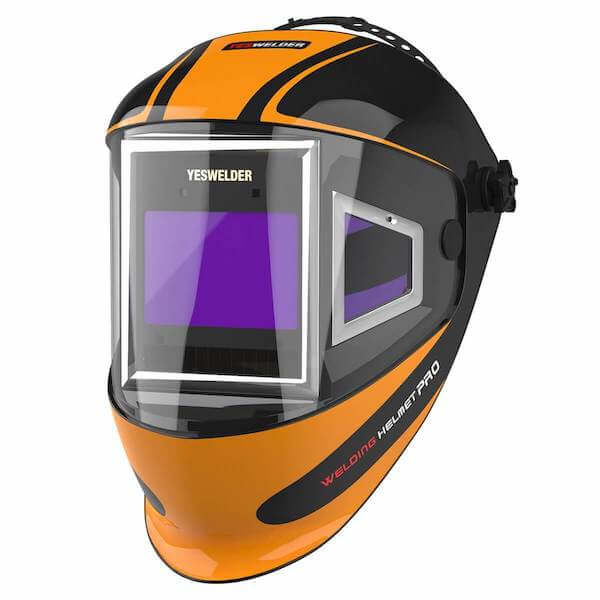
The YesWelder 900B is an excellent choice for beginners and professionals. But since it costs far less than models from ESAB, Lincoln Electric, Miller, and Optrel, it’s most attractive to rookies who want to buy a quality helmet without breaking the bank.
The true color lens offers pretty accurate color transmission. But, more expensive brands do provide a better visual experience. Still, YesWelder offers a good optical clarity rating and color accuracy at a relatively low price.
The best feature of the YesWelder 900B is the flip-up design. Big brands like 3M and Miller sell flip-up helmets at a high cost, making them inaccessible to DIYers and small shop fabricators. However, the YesWelder 900B provides a flip-up visor at a price new welders can afford. That means you don’t have to remove the helmet between the welds. Instead, flip up the auto-darkening filter (“ADF”) visor and use the clear face shield underneath.
The viewing size is large, but smaller than some of the other helmets we reviewed. It doesn’t support cheater lenses, which is a shame. But for the hobbyist or a professional on a limited budget, the YesWelder 900B is a steal. Plus, if you use our coupon code “WELDGURU10” you’ll get a 10% discount.
Pros
- Large viewing area with side DIN 5 windows for a panoramic view
- 4 sensors cover a large area for precise arc detection
- Flip-up cover design with an integrated transparent visor for grinding
- True color lens provide more accurate color transmission
- Uses digital controls like top brands
- Rechargeable battery with an integrated magnetic charging port
- 2h battery charging time offers 10 days of operation
- Low battery indicator
- Easy to set up and use
- Sturdy body
- Well-built headgear
- Includes multiple replacement lens
Cons
- Too many crevices where dust can accumulate
- Not compatible with a cheater lens
- Heavy at 2.9 lbs
How did we test the Welding helmets?
We gathered a diverse group of testers with different skill levels and preferences, and obtained a selection of helmet models from various manufacturers. We set up a controlled testing environment and had each tester try out each helmet, rating them according to predetermined criteria such as visibility, comfort, durability, and cost.
We analyzed the results and identified the helmet models that performed the best overall, and conducted further testing to confirm our findings. This thorough and systematic approach allowed us to make an informed decision on the best welding helmet for our lab or company.
We conducted our welding helmets test in a variety of contexts, from a professional welding shop to a home workshop. The purpose of the test was to determine which welding helmet offered the best protection and performance for a variety of welding tasks.
For each test, we used the same welding equipment and the same welding parameters to ensure fair results. We also tested the helmets in a variety of scenarios, from outdoor welding to indoor welding, and from welding in tight spaces to welding on large pieces.
To evaluate the helmets, we measured several factors, including visibility, comfort, ventilation, and weight. We also tested the helmets’ ability to protect against ultraviolet and infrared radiation, and we evaluated the helmets’ reaction time and response time when faced with sudden flashes of light.
We evaluated the results objectively and subjectively, and our test team included experienced welders and industry professionals. We looked at the overall performance of the helmet and its features, as well as its price point.
Overall, our tests showed that there are a variety of welding helmets on the market that can offer excellent protection and performance. The best welding helmet for a particular welder may depend on their welding needs, budget, and comfort level.
Speedglas is designed for industrial level work while still offering an exceptional level of durability.
What To Look For In Welding Helmet – Buyer’s Guide
Welding helmets are a crucial piece of welding equipment, and they are expensive. But, selecting a welding hood is not straightforward, and it’s easy to make a mistake.
So, we made a concise buying guide to help you find the welding helmet that best suits your needs.
Set Your Budget: Best Helmet Brands
The most recognised helmet brands are:
- Optrel
- ESAB
- 3M
- Miller
- Hobart
- Lincoln Electric
- Jackson Safety
Optrel, ESAB, 3M, and similar brands target professional welders whose work demands high precision and productivity. Their helmets are expensive, but one exception is ESAB’s Sentinel A50 which is relatively affordable.
While providing an exceptional welding experience, these high-end helmets don’t benefit beginners, and it is hard to justify the cost for new welders. Professional welding helmets are designed to improve productivity, reduce effort, increase weld quality, and ultimately help you earn more money. That’s why experienced welders buy them, even if they cost more.
Miller, Lincoln Electric, and Jackson Safety work great for hobby welders and professionals alike. They compete well against sophisticated helmets from the brands mentioned above. What they lack in technology, they make up with in endurance. For example, the Miller and Lincoln welding helmets can handle harsh working conditions better than the Optrel or ESAB offerings.
YesWelder, Hobart, and Ironton are geared toward the hobbyist market. Hobart is a big brand name, but their welding helmet line cannot compete with Miller or Lincoln. Hobart’s helmets are more affordable but limited in features. YesWelder’s 900B helmet comes close to the big brand names, but the warranty is not as long. Plus, YesWelder is a hobbyist-grade brand, so don’t expect the helmet to endure the same conditions as welding hoods from Miller or Lincoln.
Features To Assess
Viewport Size
The bigger the viewport, the more light will enter through the ADF. But, most importantly, with a big viewport, you’ll see more of your workspace. If you put the helmet in grind mode, you can work efficiently with a large viewing area. But, if you have a small viewport like on the Ironton helmet, you cannot complete every task without removing the helmet.
Color And Light
Once you put on a helmet from Optrel, you’ll likely not be satisfied with any other helmet’s color and light transmission. Seeing clearly with real-life colors is a must for a welding professional.
But using old, green-tinted ADF does the job, even if the welding experience is inferior. You will have to deal with things like you can hardly see the weld puddle, and you won’t be able to tell if a slight color or length change happens with the welding arc.
On the other hand, true color technology lets you see the tiniest details. So, you can prevent weld defects by reacting in real-time. Why finish the entire weld if you noticed that porosity occurred mid-way? Just stop, re-grind, and restart the weld. That’s why accurate color and light transmission saves time and money.
Lens Quality
Almost all welding helmets on the market are either 1/1/1/1 or 1/1/1/2 rated for optical clarity. Either is a good choice. The 1/1/1/1 lens provides the best image accuracy; there is no distortion. However, the 1/1/1/2 lens distorts the image slightly when looking at an angle. But, this is minimal, and unless you are a precision TIG welder, you are unlikely to have any issues with 1/1/1/2 helmets.
Just avoid helmets with a rating other than these two. There is no reason to get inferior lenses when the two best ratings are widely available nowadays.
Grind Mode
Grind mode prevents the ADF from activating and darkening your view. This mode keeps the helmet at the lightest available shade to help you see better. The shades are usually DIN 3 or DIN 4. But, some high-end helmets like Optrel Panoramaxx CLT offer DIN 2, which is near life-like illumination.
It’s always preferable for the grind mode button to be external. Hobbyists can work with an internal grind button. But, constantly taking off the helmet to click the grind mode button and putting the helmet back on is very frustrating in a professional environment.
Headgear
Your headgear quality determines the fit adjustability and comfort. For example, you cannot adjust the basic headgear provided by Ironton and Hobart for a comfortable, balanced fit. You may have gaps between the headgear straps and your head, the straps may catch your hair, and the lack of padded cushions reduces comfort.
High-end helmets from ESAB, Optrel, Miller, or Lincoln offer good headgear designs. If you weld all day, get a helmet with a headgear that allows multi-point adjustments. Properly balancing the helmet’s weight goes a long way in reducing strain, neck pain, and neck joint degeneration.
Durability
The most durable helmets usually have simple designs and heavy shells. For example, helmets from Optrel are ultra-light, but their shells are thin. While made with excellent plastics, they shouldn’t be used in extreme conditions where slag constantly falls on the shell.
On the other hand, Miller and Lincoln’s helmets have a simple design with minimal crevices and thicker shell plastic, allowing them to handle harsher conditions. But, the 3M Speedglas welding helmets are made to endure the work in the toughest welding industries like mining and construction.
Weight
Many people make the mistake of buying an overly heavy helmet just to find out that it’s uncomfortable to wear all day. If you weld occasionally, this is not much of a concern. But if you weld often, a light helmet makes the day under the hood far more pleasant.
A large viewport, sophisticated headgear design, and thick shell plastics are always welcome. But, all of these add weight, making the helmet unbearable. However, we only picked relatively light helmets in our review since this is an area that can make or break the welding experience. Still, some helmets are heavier than others. So, if welding takes a significant portion of your day, go with the lightest helmet that gives you all the features you need.
Lastly, this goes without saying, but the helmet should meet safety standard ANSI Z87.1.